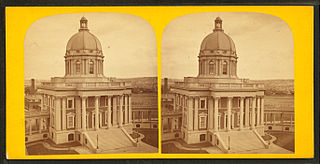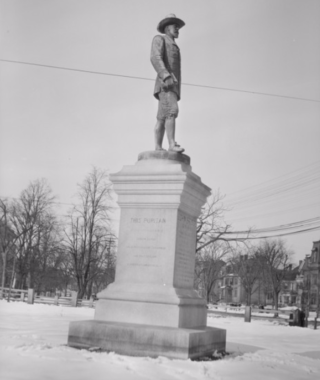
John Harvard (1607–1638) was an English dissenting minister in colonial New England whose deathbed bequest to the "schoale or colledge" founded two years earlier by the Massachusetts Bay Colony was so gratefully received that it was consequently ordered "that the Colledge agreed upon formerly to be built at Cambridge shalbee called Harvard Colledge." John Harvard was born in Southwark, England. A graduate of Emmanuel College of the University of Cambridge, he emigrated to New England in 1637. Harvard University considers him the most honored of its founders—those whose efforts and contributions in its early days "ensure[d] its permanence"—and a statue in his honor is a prominent feature of Harvard Yard.

Harvard Yard, in Cambridge, Massachusetts, is the oldest part of the Harvard University campus, its historic center and modern crossroads. It contains most of the freshman dormitories, Harvard's most important libraries, Memorial Church, several classroom and departmental buildings, and the offices of senior University officials including the President of Harvard University.

The Boston Common is a public park in downtown Boston, Massachusetts. It is the oldest city park in the United States. Boston Common consists of 50 acres (20 ha) of land bounded by Tremont Street, Park Street, Beacon Street, Charles Street, and Boylston Street.

Charles Francis Adams Jr. was an American author, historian, and railroad and park commissioner who served as the president of the Union Pacific Railroad from 1884 to 1890. He served as a colonel in the Union Army during the American Civil War. After the war, he was a railroad regulator and executive, an author of historical works, and a member of the Massachusetts Park Commission.

The Freedom Trail is a 2.5-mile-long (4.0 km) path through Boston that passes by 17 locations significant to the history of the United States. It winds from Boston Common in downtown Boston, to the Old North Church in the North End and the Bunker Hill Monument in Charlestown. Stops along the trail include simple explanatory ground markers, graveyards, notable churches and buildings, and a historic naval frigate. Most of the sites are free or suggest donations, although the Old South Meeting House, the Old State House, and the Paul Revere House charge admission. The Freedom Trail is overseen by the City of Boston's Freedom Trail Commission and is supported in part by grants from various non-profit organizations and foundations, private philanthropy, and Boston National Historical Park.

Harvard University Press (HUP) is a publishing house established on January 13, 1913, as a division of Harvard University, and focused on academic publishing. It is a member of the Association of University Presses. After the retirement of William P. Sisler in 2017, the university appointed as George Andreou as director.

Oliver Wolcott Gibbs was an American chemist. He is known for performing the first electrogravimetric analyses, namely the reductions of copper and nickel ions to their respective metals.

Guy Lowell, was an American architect and landscape architect.

The Great Bridge over the Charles River connected Cambridge, Massachusetts, to what is now known as Allston, Boston, Massachusetts. The Great Bridge was built in 1660–1662 at what was then called Brighton Street, and was the first bridge to span the Charles. A toll was authorized in 1670. The bridge was rebuilt in 1862.
Clarence Crane Brinton was an American historian of France, as well as a historian of ideas. His most famous work, The Anatomy of Revolution (1938) likened the dynamics of revolutionary movements to the progress of fever.

The Charles River Esplanade of Boston, Massachusetts, is a state-owned park situated in the Back Bay area of the city, on the south bank of the Charles River Basin.

The Boston City Hospital (1864–1996), in Boston, Massachusetts, was a public hospital located in the South End. It was "intended for the use and comfort of poor patients, to whom medical care will be provided at the expense of the city, and ... to provide accommodations and medical treatment to others, who do not wish to be regarded as dependent on public charity."

Cambridge Common is a public park and National Historic Landmark in Cambridge, Massachusetts, United States. It is located near Harvard Square and borders on several parts of Harvard University. The north end of the park has a large playground. The park is maintained by the Cambridge Department of Public Works.

Memorial Hall, immediately north of Harvard Yard in Cambridge, Massachusetts, is a large High Victorian Gothic building honoring Harvard men's sacrifices in defense of the Union during the American Civil War—"a symbol of Boston's commitment to the Unionist cause and the abolitionist movement in America."

The Cambridge Police Department is the municipal police department for the city of Cambridge, Massachusetts, in the United States. Formally organized in 1859. with the appointment of John C. Willey as the first chief of police, the Cambridge Police Department was then staffed by only 16 officers. The Cambridge Police Department moved its headquarters location on December 8, 2008. The police department is now located in the Robert W. Healy Public Safety Facility at 125 Sixth Street in the neighborhood of East Cambridge, leaving their Central Square location after 135 years.

The Brattle Street Church (1698–1876) was a Congregational and Unitarian church on Brattle Street in Boston, Massachusetts.

Tory Row is the nickname historically given by some to the part of Brattle Street in Cambridge, Massachusetts, where many Loyalists had mansions at the time of the American Revolutionary War, and given by others to seven Colonial mansions along Brattle Street. Its historic buildings from the 18th century include the William Brattle House and the Longfellow House–Washington's Headquarters National Historic Site. Samuel Atkins Eliot, writing in 1913 of the seven Colonial mansions making up Tory Row, called the area "not only one of the most beautiful but also one of the most historic streets in America." Owners of Caribbean slave plantations, including the Vassall and Royall families, built the mansions as a statement of the "incredible wealth" they had amassed from slave labor in Jamaica and Antigua, and they enslaved an unusually high number of people on the premises.
This is a timeline of the history of the city of Cambridge, Massachusetts, United States.

The John Bridge Monument, in the northeast corner of the Cambridge Common in Cambridge, Massachusetts, was given by Samuel James Bridge in honor of his ancestor John Bridge (1578–1665) and sculpted by Thomas R. Gould.

The Washington Gate, or Washington Memorial Gate, is a Milford pink granite gate installed at Cambridge Common in Cambridge, Massachusetts, United States. Each of the walls extending from the gate has a bronze tablet. It was presented by the Daughters of the American Revolution and dedicated on October 19, 1906.



















